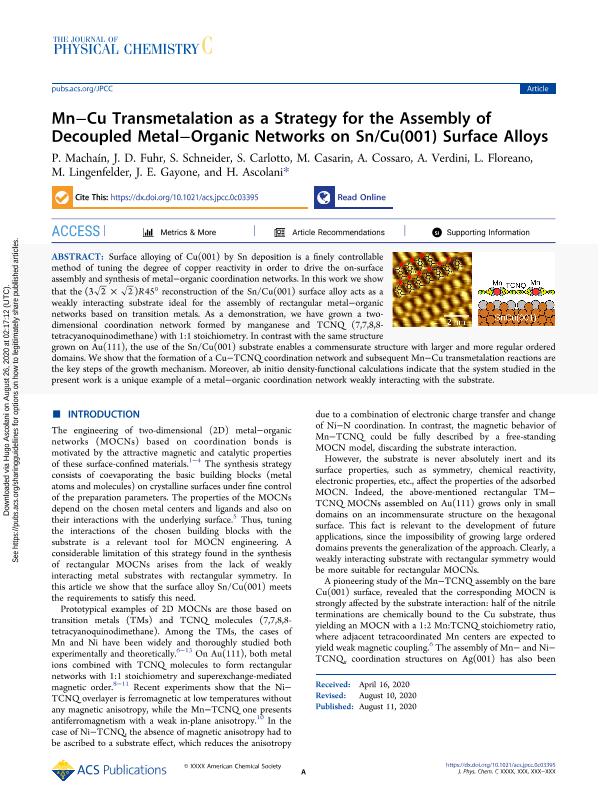Artículo
Mn-Cu Transmetalation as a Strategy for the Assembly of Decoupled Metal-Organic Networks on Sn/Cu(001) Surface Alloys
Machain, Paloma ; Fuhr, Javier Daniel
; Fuhr, Javier Daniel ; Schneider, S.; Carlotto, Silvia; Casarin, M.; Cossaro, A.; Verdini, A.; Floreano, L.; Lingenfelder, Magalí Alejandra; Gayone, Julio Esteban
; Schneider, S.; Carlotto, Silvia; Casarin, M.; Cossaro, A.; Verdini, A.; Floreano, L.; Lingenfelder, Magalí Alejandra; Gayone, Julio Esteban ; Ascolani, Hugo del Lujan
; Ascolani, Hugo del Lujan
 ; Fuhr, Javier Daniel
; Fuhr, Javier Daniel ; Schneider, S.; Carlotto, Silvia; Casarin, M.; Cossaro, A.; Verdini, A.; Floreano, L.; Lingenfelder, Magalí Alejandra; Gayone, Julio Esteban
; Schneider, S.; Carlotto, Silvia; Casarin, M.; Cossaro, A.; Verdini, A.; Floreano, L.; Lingenfelder, Magalí Alejandra; Gayone, Julio Esteban ; Ascolani, Hugo del Lujan
; Ascolani, Hugo del Lujan
Fecha de publicación:
08/2020
Editorial:
American Chemical Society
Revista:
Journal of Physical Chemistry C
ISSN:
1932-7447
Idioma:
Inglés
Tipo de recurso:
Artículo publicado
Clasificación temática:
Resumen
Surface alloying of Cu(001) by Sn deposition is a finely controllable method of tuning the degree of copper reactivity in order to drive the on-surface assembly and synthesis of metal-organic coordination networks. In this work we show that the (32×2)R45° reconstruction of the Sn/Cu(001) surface alloy acts as a weakly interacting substrate ideal for the assembly of rectangular metal-organic networks based on transition metals. As a demonstration, we have grown a two-dimensional coordination network formed by manganese and TCNQ (7,7,8,8-tetracyanoquinodimethane) with 1:1 stoichiometry. In contrast with the same structure grown on Au(111), the use of the Sn/Cu(001) substrate enables a commensurate structure with larger and more regular ordered domains. We show that the formation of a Cu-TCNQ coordination network and subsequent Mn-Cu transmetalation reactions are the key steps of the growth mechanism. Moreover, ab initio density-functional calculations indicate that the system studied in the present work is a unique example of a metal-organic coordination network weakly interacting with the substrate.
Palabras clave:
SUPERFICIES
,
COORDINACIÓN
,
STM
,
MANGANESO
Archivos asociados
Licencia
Identificadores
Colecciones
Articulos (UE-INN - NODO BARILOCHE)
Articulos de UNIDAD EJECUTORA INSTITUTO DE NANOCIENCIA Y NANOTECNOLOGIA - NODO BARILOCHE
Articulos de UNIDAD EJECUTORA INSTITUTO DE NANOCIENCIA Y NANOTECNOLOGIA - NODO BARILOCHE
Articulos(IFISUR)
Articulos de INSTITUTO DE FISICA DEL SUR
Articulos de INSTITUTO DE FISICA DEL SUR
Citación
Machain, Paloma; Fuhr, Javier Daniel; Schneider, S.; Carlotto, Silvia; Casarin, M.; et al.; Mn-Cu Transmetalation as a Strategy for the Assembly of Decoupled Metal-Organic Networks on Sn/Cu(001) Surface Alloys; American Chemical Society; Journal of Physical Chemistry C; 124; 35; 8-2020; 18993-19002
Compartir
Altmétricas



